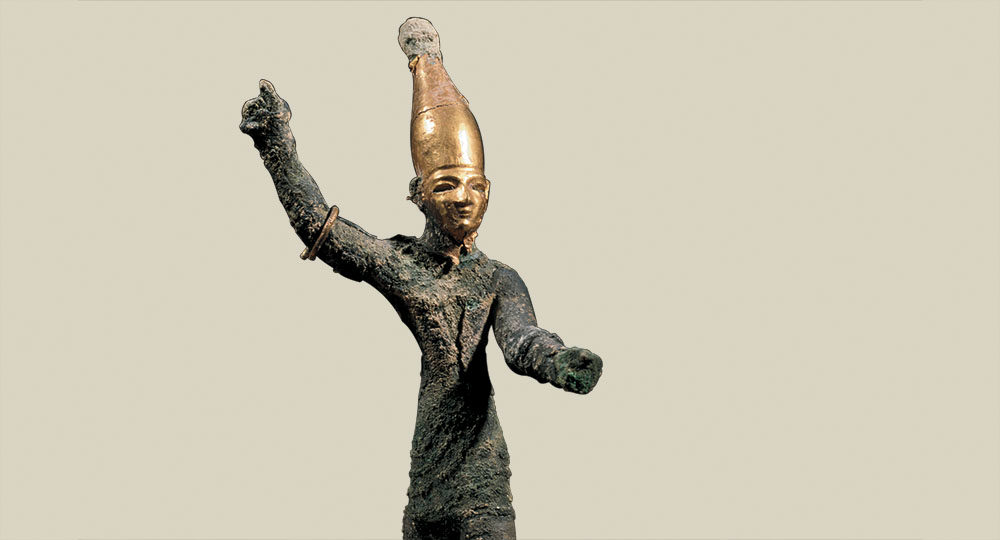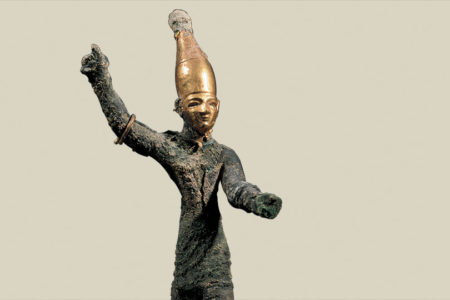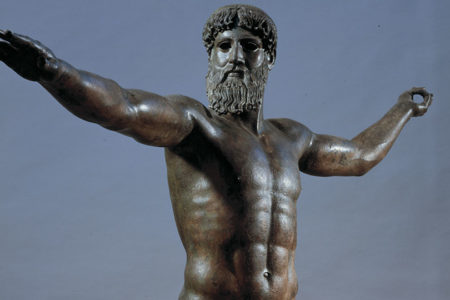The Battle of the Gods: Paganism’s Seduction of Israel
The call had gone out nationwide to assemble at Mount Carmel. Now the peak was bustling with thousands of people. King Ahab was there. Also present were 450 prophets of Baal and 400 prophets of the Asherah. Standing before the throng was a man wearing a hairy garment and a leather belt around his waist. It was Elijah the Tishbite. Approaching the wary onlookers, Elijah’s voice boomed out: “How long halt ye between two follow him.” And the people answered him not a word.
This well-known confrontation, found in 1 Kings 18, epitomizes the centuries-long struggle Israel has had in keeping the covenant they made with God through Moses (Ex. 24). “All the words which the Lᴏʀᴅ hath said will we do,” they had twice exclaimed (vv. 3, 7). But the Lord knew better. Before Moses died, God revealed to him that Israel would “play the harlot after the strange gods of the land” (Dt. 31:16). This they did. What caused Israel to so easily betray the covenant relationship they had with the God who had redeemed them?
Seducing Spirits
Before 1929, little was known about the Canaanite pantheon other than what was found in the Bible. That year, archaeological excavations along the coast of northern Syria revealed the remains of a once thriving city called Ugarit. Today, Ras Shamra, as the area is locally known, is considered to be one of the greatest archaeological finds of the 20th century. Yielding hundreds of objects, Ras Shamra has brought to light fascinating details concerning pagan deities and rites referred to in the Bible. Scores of clay tablets describe the mythology of Ugarit’s gods. By the time of the judges, Ugarit was no longer an active metropolis, but the worship of their false gods continued to flourish throughout the region.
These gods included El, the old chieftain and progenitor of the remaining gods. El’s wife was known as Athirat (Asherah or grove in the Bible). It is believed the object of worship for Asherah was a pole or image made of wood.
The most popular pagan god was known as Baal (Lord or Master). Baal was the son of El and Asherah. One account refers to him as the son of Dagon, the god of the Philistines (Jud. 16:23). Baal was the male god of fertility, both in human reproduction and agriculture. He was responsible for bringing the rain in the winter season to assure abundant crops. One stone carving of Baal depicts him wielding a club (thunder) in his raised right hand and a spear (lightning) in his left hand. Baal is also portrayed as a bull, an ancient symbol of fertility. Compound names of Baal are sometimes found in Scripture, such as Baalzebub (2 Ki. 1:2) or Beel-zebub (Mt. 12:24), meaning master of the flies. The Jewish leaders in Jesus’ time understood Beel-zebub to be the prince of the devils, Satan himself.
A central account of Baal in Ugaritic epics depicts him as struggling with Mot, the god of famine, drought, and death. Baal was required to go to the realm of the dead for a time. With the aid of his sister and consort—the eternal virgin and mother, Anat (goddess of eroticism and war—Baal was eventually brought back to the realm of the living and took his seat on the throne, making Mot subservient to him. This cycle repeated itself every summer (the death of Baal) and winter (the resurrection of Baal).
Another goddess of eroticism and war at Ugarit was Athtart. In the Old Testament, she is referred to as Ashtoreth (pl., Ashtaroth). After Saul was slain by the Philistines, his armor was placed in the temple of Ashtaroth in honor of the victory (1 Sam. 31:10). Athtart was “originally androgynous, being male in the morning and female in the evening” (W. F. Albright, Archaeology and the Religion of Israel, p. 83). As a male, Athtart was known as Athtar and corresponded to the Moabite god Chemosh, as well as the Ammonite god Milcom, or Molech (1 Ki. 11:33).
Along with the biblical texts, the evidence found at Ras Shamra gives insight into the nature of the Canaanite religious rituals. In brief, they were characterized by drunkenness, sexual perversion, and violence.
Baal worship commonly took place at a temple on a hill (see 2 Ki. 10:18–27). These structures were similar to the Jewish Temple, with an outer court for sacrifices and liturgy, an inside room for gathering, and a further inner room containing statuary. Sacrifices were also performed in a tower located on top of the building. As part of the ceremony, priests and participants reenacted the events narrated in the Ugaritic story. This reenactment may even have included bestiality, since Baal, the bull, is said to have mated repeatedly with a heifer before he entered the place of the dead. Following this, the worshipers participated in ritual mourning. They mourned the demise of Baal. This ritual involved loud moaning and slashing the flesh, similar to the description of Anat’s mourning over Baal: “Of Baal she scraped her skin with a stone, with a flint for a razor she shaved her sidewhiskers and beard; she harrowed her collar-bone, she ploughed her chest like a garden, she harrowed her waist like a valley, saying: ‘Baal is dead!’” (J. C. L. Gibson, Canaanite Myths and Legends, p. 74). This is reminiscent of the self-mutilation performed by the prophets of Baal on Mount Carmel (1 Ki. 18:28). After the mourning, gladness ensued in celebration of Baal’s resurrection and subsequent enthronement. Feasting, drinking, and sexual promiscuity, assisted by temple prostitutes, characterized the merrymaking.
Few details are known about the Molech and Chemosh rituals, except that horrendous child sacrifice was employed (Lev. 18:21; Dt. 12:31; 2 Ki. 3:27). Often the child would “pass … through the fire” as food for the voracious god (Ezek. 23:37). Throughout the Middle East, archaeologists have found numerous funerary urns containing the charred bones of animals and children. The citizens of ancient Carthage sacrificed children to their god Cronus (who, according to mythology, unsuccessfully tried to murder his own children). “There was in their city a bronze image of Cronus, extending its hands, palms up and sloping toward the ground, so that each of the children when placed thereon rolled down and fell into a sort of gaping pit filled with fire” (Diodorus of Sicily, Book 20, 14.6). Since the Carthaginians were descendants of Phoenician colonists, it is likely this sacrifice to Cronus was similar to the Molech and Chemosh sacrifices performed in Phoenicia. In fact, one rabbinical commentary describes similar sacrifices to Molech near Jerusalem. A hollow statue of Molech was located within the seventh and innermost chamber of his temple. No one could enter this chamber without bringing a child for a sacrifice. The statue had its hand outstretched holding a copper plate on which was a fire-pan. “They [the priests] placed the child on the copper plate, kindled the fire-pan beneath him, and sang before the image, ‘May the sacrifice be pleasant and sweet to thee!’ Why did they do this? So that the parents should not hear the groans of their children and retract” (Lamentations Rabbah 1.9, sec. 36).
Other Canaanite practices included the construction of open air shrines, known in the Bible as “high places,” where sacrifices were performed and incense was commonly burned (2 Ki. 17:11). One excavated high place, found in the ancient city of Dan and dating back to the time of King Ahab, measures 60 by 62 feet.
Spiritual Infidelity
Despite repeated warnings from God not to adopt the customs of the pagan nations around them (Lev. 18:3), Israel did just that. Its downward spiral began at the foot of Mount Sinai with the forging of the golden calf (Ex. 32). During their forty-year trek in the wilderness, some Israelites carved images of foreign deities (Acts 7:42–43). Next, they fell into Baal worship through the enticements of the Moabite women at Peor (Num. 25:1–3). This Baal worship consisted of eating sacrifices offered to the dead (Ps. 106:28). Following the death of Joshua and the elders, Israel began to “play the harlot” with the Canaanite gods in earnest. After the judges, King Saul removed the mediums and spiritists, except for one, the medium at Endor, of whom he himself inquired (1 Sam. 28). The people of Israel continued to sacrifice and burn incense on the high places throughout the land (1 Ki. 3:2), despite the strict injunction against it (Dt. 12:13–14). In the twilight years of his life, swayed by the charms of his multitudinous foreign wives, King Solomon built places of worship for each of their pagan gods (1 Ki. 11:5–8). He even provided a site on the Mount of Olives for the worship of Chemosh and Molech. Solomon’s corrupted leadership set the tone and pattern for Israel’s future kings and their subjects for generations to come.
Both the northern kingdom of Israel and the southern kingdom of Judah practiced gross idolatry (2 Ki. 17:7–19). They fashioned two golden calves. They aggressively worshiped Baal, Asherah, Ashtaroth, Molech, and Chemosh. They built shrines for pagan deities in every location—from town to watchtower to groves. They erected idols and carved images within the Temple of God (2 Ki. 21:7; Ezek. 8:10). They worshiped the sun, moon, and stars. They burned incense on their roofs (Jer. 32:29), on the hilltops, and under every green tree. They engaged in unbridled sexual promiscuity (Amos 2:7–8), together with both male and female cultic prostitution (1 Ki. 14:24; Hos. 4:13–14). They practiced witchcraft, divination, sorcery, and spiritism (2 Ki. 21:6). They sacrificed to demons (Dt. 32:17) and consulted with the dead (Isa. 8:19), spending nights among the tombs’ (Isa. 65:4). They slaughtered their children, especially the firstborn (Ezek. 20:26), burning them in sacrificial furnaces in the valley of Hinnom (Gehenna of the New Testament), south of Jerusalem (Jer. 32:35). For 700 years, they burned incense to the bronze serpent Moses had made in the wilderness (2 Ki. 18:4).
Every abominable thing that God had instructed them not to do, they did, and even more. Judah’s iniquity surpassed even that of the Canaanites (2 Ki. 21:9). And, like the Canaanites, the result of their defilement was for the land to spew them out (Lev. 18:25–28).
Sanctified Devotion
Although Baal proved to be a rather impotent storm god at the contest on Mount Carmel, history shows that Israel continued to struggle with the first of the ten commandments: “Thou shalt have no other gods before me” (Ex. 20:3). This struggle has lasted even to this day among the Diaspora, just as Moses predicted (Dt. 28:64). Israel’s future is bright, however. A cleansing is in store for them (Isa. 4:4), along with the removal of all idols (Isa. 2:18).
One possible reason Israel engaged in polytheism was a craving to be like everyone else. God had planned for Israel to be separate, a holy nation, a people that dwelt apart. Instead, Israel “mingled among the nations” (Ps. 106:35). They reasoned, “We will be as the nations” (Ezek. 20:32). According to Josephus, the argument used by the Moabite women at Peor was peer pressure; thus, they gave in to the pressure (Antiquities, 4.6.8). Later, when Israel demanded a king, their motivation was, “That we also may be like all the nations” (1 Sam. 8:20).
Surrounded by a sea of pagan uniformity, it was difficult for Israel to remain distinct. They attempted, not so much to replace Jehovah, but to syncretize and blend Him in with all the other so-called gods. The effect obscured Israel’s true distinguishing mark—the genuine presence of God in their midst (Ex. 33:16).
If we are not careful, the same could become true of us. As Christians, we too are a peculiar people. Although less overtly idolatrous, our modern culture is very similar to that of the ancient Canaanites. Our society is saturated with violence, debauchery, and the expenditure of children through abortion. Similar to Old Testament Israel, we are tempted to concede biblical truths for the sake of blending in and appearing tolerant. Israel’s example should be a warning to us of the danger of attempting to drink the cup of the Lord along with the cup of demons (1 Cor. 10:21). When we agree to conform to the world and acquiesce to Satan’s counterfeits, we too end up obscuring the one characteristic that distinguishes us from the rest of humankind—the genuine presence of God in our lives.
Elijah’s forthright challenge speaks to us today, as it does to every generation: “How long halt ye between two opinions? If the Lᴏʀᴅ be God, follow him; but if Baal, then follow him.” What will be our choice?








This article was excellent!
Living today, I think it’s easy to think of how evil the world is. BUT if we truly understand what was taking place during the OT times, we would see that the evil they experienced was just as evil, if not more so… so many things seemed like it was just OUT IN THE OPEN. I know we are there too especially with all of the sexualization of everything. But this helped me have a visual of how CONFUSED these people were. When I read Judges 17 and 18, I was jaw dropped at all that was taking place. But 17:6 sums it all all up: “ In this days Israel had no king; all the people did whatever seemed right in their OWN eyes” sound familiar… this is to a T what we see today… this article was excellent! Thank you!!
Yahweh was also a pagan god, who once was worshiped alongside his wife, Asherah, a goddess of fertility. You can google this. He is not our Heavenly Father and the Father of Jesus, our Savior. At least, I don’t believe this to be true. I think Jesus was trying to tell us this. ” In the beginning was the Word, and the Word was with God, and the Word was God. 2 The same was in the beginning with God. 3 All things were made by him; and without him was not any thing made that was made. 4 In him was life; and the life was the light of men. 5 And the light shineth in darkness; and the darkness comprehended it not.” John 1-5 (KJV). How else can you explain the blood sacrifices and slaughtering of innocent women and children by “Yahweh” in the old Testament? He even calls himself a “God of War”. Jesus is the exact opposite. He said: “I and the Father are one and the same.” For bible verses that prove this, see the “Good God” videos on youtube.
Yahweh was not a “pagan” god in the way that you presume. Yahweh was king of the gods; multiple verses state that he created all the “gods” that later governed what we now call “pagan” nations.
Yahweh did not command that every city conquered by the Israelites be subjected to the same mass-slaughter that you mention above. Those massacres were reserved for specific cities that were rendered “kherem,” meaning “set apart to the Lord for destruction.” From the biblical text you can see that these cities that were to be “kherem” were those who had religious or genetic ties to the Nephilim, the Anakim, the Rephaim . . . “heroes of old, men of renown” which Genesis 6 states are the offspring of cohabitation between rebellious angels and human women. God told the Israelites to completely eradicate THOSE people groups. He was very merciful, comparitively speaking, with the rest of the cities that they were told to conquer. The conquest of the promised land was NOT a genocide as you and others make it out to be. But it definitely WAS an extermination of an evil race of half human half deity warrior demi-gods. Again, from the biblical text, you can see that Israel kept on fighting these Nephilim/Anakim/Rephaim well into the establishment of the Kingdom. Goliath and his siblings were members of these tribes.
Is not Yahweh the Tetragrammaton?
For the personal name of Jesus father ,
Yahweh pagan ? A delusional and misguided thought indeed !
Mr. Scott:
Thank you very much for this very insightful and well-researched article. This will be very helpful to me in ministry.
Blessings in Christ.
Brig Jones
Thank you, this fills a lot of holes I had that connotes a relationship with paganism and the Jews. I believe a push is being made by the royal family to bring the commonwealth back to paganism and to once again lure Israel in. Just look at the opening ceremonies to the commonwealth games – 70 nations all actively worshipping Moloch.